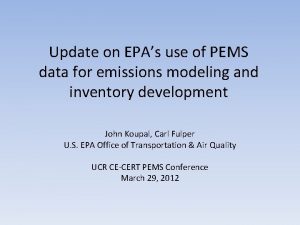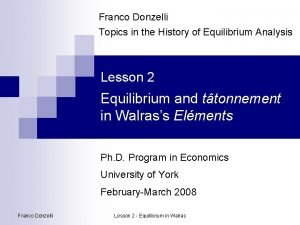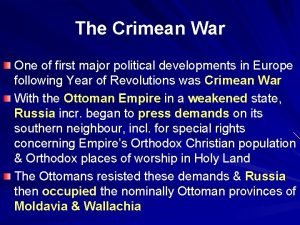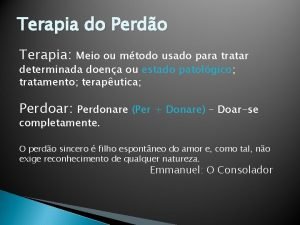PEMS data analysis at ICCT Vicente Franco Francisco




















- Slides: 20

PEMS data analysis at ICCT Vicente Franco, Francisco Posada, Peter Mock Presentation RDE-LDV group Brussels, Sept. 16 2013

Contents § ICCT approach to PEMS data analysis § ICCT standard PEMS charts § A modest proposal

ICCT approach to PEMS data analysis § Problem § PEMS campaigns by contractors § Data and analysis commissioned together § Different contractors performs different analyses § No direct control over type of analysis, quality § Some inconsistencies, makes comparisons difficult § Solution § Commission PEMS testing + (methodological) campaign report excluding data analysis, develop semi-automatic, standard data analysis formats

ICCT approach to PEMS data analysis § ICCT’s Standard PEMS trip report charts § Goal: to have a standard set of charts that characterize individual PEMS trips and real-world emission behavior of vehicles § § Compare real-world to laboratory, emission limits Compare different trips Compare different vehicles Support scientific analyses, not (just) compliance checks § Analysis method draws from RDE-LDV interim methods

ICCT standard PEMS charts § Standard PEMS trip report charts § Workflow: MATLAB script that loads PEMS datasheets, applies MAW method (also simplified CLEAR w/o weighting) § Set of standard plots (from aggregate to detailed assessments) § Ready for publishing (eps format) § Adapts to different data sources, ‘batch’ mode § Not a standalone tool (requires MATLAB scripting)

ICCT standard PEMS charts: trip overview Generated for individual trips or collections of trips Quick qualitative assessment of driving conditions

ICCT standard PEMS charts: comparison to emission limits

Standard plots: pollutants by window Standard visualization of CO 2 windows, one trip

Standard plots: pollutants by window

Standard plots: distance-specific emissions One or several trips (time dimension preserved) Fuel-specific version possible

Standard plots: distance-specific emissions

Standard plots: pollutant scatterplots Investigation of correlation between emissions and window average gradient, power, etc. Marker size proportional to window distance

Distribution of driving modes

Standard plots: ‘emission map’ Preferred approach: not to derive ‘map’ plots from OBD data (GPS instead)

‘Map’ instantaneous emission plots Scatterplots of instantaneous emissions @ 3 -second bins • Not used to assess compliance • Illustration of emission events

A modest proposal Proposal: to make a smooth classification of windows based on their distance-specific CO 2 emissions Reasoning: aggressive driving, high-speeds, uphill driving, cold-start, cold ambient temperature, etc. all translate intro increased CO 2 emissions. Distance-specific window emissions should get multiplied by a factor <1 when distance-specific CO 2 over the window is higher than for the reference cycle:

A modest proposal

A modest proposal

A modest proposal Advantages of distance-specific CO 2 weighting: • Smooth weighting is fairer than discrete areas; distance-specific CO 2 is easily determined (no subcycle data required, no curve fitting, no extrapolation) • Compatible with the subsequent application of an NTE limit

PEMS data analysis at ICCT Vicente Franco, Francisco Posada, Peter Mock Presentation RDE-LDV group Brussels, Sept. 16 2013
 Pems emissions modeling
Pems emissions modeling Political movement and beliefs joseph stalin
Political movement and beliefs joseph stalin Generalissimo francisco franco is still dead
Generalissimo francisco franco is still dead Nazi party apush
Nazi party apush Gil vicente vida e obra
Gil vicente vida e obra Homework out
Homework out Raul de mello franco junior
Raul de mello franco junior Padu franco
Padu franco Minuscola carolina
Minuscola carolina Unesco mappa concettuale
Unesco mappa concettuale Franco donzelli
Franco donzelli Franco donzelli
Franco donzelli Veronica franco biografia
Veronica franco biografia Divaldo franco bezerra de menezes
Divaldo franco bezerra de menezes Franco-prussian war results
Franco-prussian war results Esposa de divaldo franco
Esposa de divaldo franco Franco-prussian war results
Franco-prussian war results Terapia do perdão divaldo franco
Terapia do perdão divaldo franco Franco pinna mandrione
Franco pinna mandrione Reino franco
Reino franco Franco's fast food maths problem answer
Franco's fast food maths problem answer





































